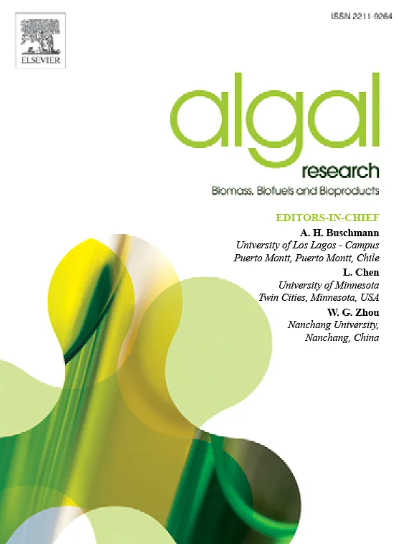纳米纤维素基质中蓝藻生长的非侵入性监测
IF 4.5
2区 生物学
Q1 BIOTECHNOLOGY & APPLIED MICROBIOLOGY
Algal Research-Biomass Biofuels and Bioproducts
Pub Date : 2025-05-09
DOI:10.1016/j.algal.2025.104090
引用次数: 0
摘要
用于可持续化学品生产的固态光合细胞工厂(SSPCFs)可以向工业相关环境发展,并对其操作进行快速反馈控制。这需要对固定的细胞进行非侵入性的原位监测,而现有的方法是不可能的。我们在光合有效辐射范围(400-700 nm)部署了高光谱成像来实现这种监测。通过研究2,2,6,6-四甲基胡椒啶1-氧(TEMPO)氧化纤维素纳米纤维水凝胶厚度、固定化Synechocystis sp. PCC 6803细胞密度和时间对固定化细胞吸收光谱的影响,系统地评估了固定化过程中细胞的生长和潜在应激。时间和凝胶厚度共同占光谱变化的近80%。然后,我们校准了叶绿素a的成像光谱,以非侵入性地估计基质中健康细胞的生长。在甲醇提取样品的高光谱成像和分光光度法参考之间观察到叶绿素a有希望的相关性(模型决定系数,R2 = 0.90),而不考虑基质中随时间发展的空间差异。图像像素的聚类使得从整个矩阵区域无创地分析叶绿素a浓度的这些差异成为可能。在未来,这种非侵入性数据驱动的方法可以进一步发展,用于监测SSPCFs的生物智能化学品生产、污染、应激和细胞生长。本文章由计算机程序翻译,如有差异,请以英文原文为准。

Non-invasive monitoring of cyanobacteria growth in a nanocellulose matrix
Solid-state photosynthetic cell factories (SSPCFs) for sustainable chemicals manufacturing can be developed towards industrially relevant environment with rapid feedback control over their operation. This requires non-invasive monitoring of the immobilized cells in situ, which is not possible with existing methods. We deployed hyperspectral imaging in the photosynthetically active radiation range (400–700 nm) to enable such monitoring. We systematically assessed cell growth and potential stress during immobilization by studying how 2,2,6,6-tetramethylpiperidine 1-oxyl (TEMPO)-oxidized cellulose nanofiber hydrogel thickness, immobilized Synechocystis sp. PCC 6803 cell density and time affected the immobilized cells' absorbance spectra. Time and gel thickness together accounted for almost 80 % of the changes in the spectra. We then calibrated the imaging spectra for chlorophyll a to non-invasively estimate growth of healthy cells in the matrices. Promising correlation for chlorophyll a (model coefficient of determination, R2 = 0.90) was observed between hyperspectral imaging and spectrophotometry references from methanol-extracted samples regardless of spatial differences that developed in the matrices over time. Clustering of the image pixels enabled analyzing these differences in the chlorophyll a concentration non-invasively from the whole matrix areas. In the future, this non-invasive data-driven method could be further developed for monitoring SSPCFs' biointelligent chemicals production, contamination, stress and cell growth.
求助全文
通过发布文献求助,成功后即可免费获取论文全文。
去求助
来源期刊

Algal Research-Biomass Biofuels and Bioproducts
BIOTECHNOLOGY & APPLIED MICROBIOLOGY-
CiteScore
9.40
自引率
7.80%
发文量
332
期刊介绍:
Algal Research is an international phycology journal covering all areas of emerging technologies in algae biology, biomass production, cultivation, harvesting, extraction, bioproducts, biorefinery, engineering, and econometrics. Algae is defined to include cyanobacteria, microalgae, and protists and symbionts of interest in biotechnology. The journal publishes original research and reviews for the following scope: algal biology, including but not exclusive to: phylogeny, biodiversity, molecular traits, metabolic regulation, and genetic engineering, algal cultivation, e.g. phototrophic systems, heterotrophic systems, and mixotrophic systems, algal harvesting and extraction systems, biotechnology to convert algal biomass and components into biofuels and bioproducts, e.g., nutraceuticals, pharmaceuticals, animal feed, plastics, etc. algal products and their economic assessment
 求助内容:
求助内容: 应助结果提醒方式:
应助结果提醒方式:


